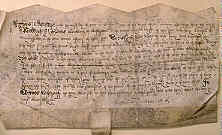



If you are looking at this page without frames, there is more information about medieval writing to be found by going to the home page (framed) or the site map (no frames).
| Diplomatic (2) | |||
 |
|||
| Private charter of 1444, involving land transactions in Essex, from the private collection of Rob Schäfer. (Photograph © Rob Schäfer) | |||
| The English private charter, involving transactions between individuals rather than the granting of privileges by the crown, follows the format of the royal charter, with some simplifcation of language. The validating insignia are the seals, attached as usual by parchment tags to the lower fold of the document. The seals of five parties to the agreement survive on this example, but, unlike the royal seal, they are small, single sided specimens. | |||
 |
In some cases the general appearance of the document gives you a clue as what it is. An indenture or chirograph is a legal agreement between two parties which was entered in duplicate on a sheet of parchment. Sometimes the word chirographum, or another word, was written in the space between the two copies. It was then cut in two in a zigzag pattern and each party took a piece, ratified with the seal of the other party. The agreement could be confirmed at a later date by showing that the two pieces fitted together. If you find a document with a zigzag edge, it is a dead giveaway that this is what you have, even before you try to read it. | ||
| Indenture of the reign of Henry VIII, from a private collection. | |||
 |
|||
| Petition to the king of 1449 (London, National Archives, E.28/79/30). By permission of the National Archives. | |||
| Petitions presented to the king were simple in format, but had certain particularities of style. They tended to be long and narrow, with a brief text. A brief address to the king was followed by a plea to his grace or compassion, and the business was stated as briefly as possible. If a lot of detail was required, it was attached to a separate document. | |||
 |
Notarial document of 1281, comprising an appeal to the Holy See by the Prior of Holy Trinity, York, over the appointment of a priest to the church of St Helen, Fishergate. From the private collection of Rob Schäfer. (Photograph © Rob Schäfer) | ||
| A document drawn up by a notary has its own giveaway item of layout and design in the form of the often elaborate notary's mark which usually adorns the lower left of the page. Beside it is written the notary's authenticating statement. There is no seal, as the notary's mark is the validating instrument. | |||
| As a potted description of the art of diplomatic, this may have a real paleographer rolling in his grave (or his swivel chair if he’s still with us), but the intention is merely to show that this is not a subject which bites. It is a collection of knowledge about standardised ways of doing things, which can be as general or as highly specific as you need it to be. Many classes of documents can be recognised by simple aspects of layout or design, and a little knowledge of the standard forms of words can help with comprehension. To look at some examples of these formats, carry on to the examples of diplomatic. | |||
|
|
|||
|
|
|||
|
|
|||
|
If you are looking at this page without frames, there is more information about medieval writing to be found by going to the home page (framed) or the site map (no frames). |
|||